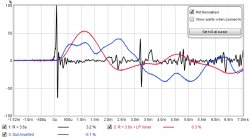jtalden
Senior Member
More
- Preamp, Processor or Receiver
- Marantz AV7705 Pre/Pro
- Main Amp
- VTV 6 chnl NC252MP P-amp x 2
- Additional Amp
- Behringer DCX2496 x 2
- Universal / Blu-ray / CD Player
- OPPO BDP-103 Universal Player
- Front Speakers
- DIY SEAS H1456/H1212 Spkr x 5
- Subwoofers
- DIY JBL 2235H 15" SW x 2
- Video Display Device
- JVC DLA-X790R
- Screen
- Da-Lite Da-Snap 39105V - 92"
I was busy today. I will explain my process in more detail tomorrow.
I understood you adjusted the mains delay. I normally analyze the delay needed using the SW as the variable. I do this as because the phase is more easily read when 0 ms is defined at the high frequency driver impulse. More delay on the SW is the same as reducing delay on the main. Which one to actually adjust is dependent on the system setup.
I normally measure only L, R, SW, then set 0 ms at the tweeter Impulse, then copy the SW measurement. That way I can move SW-Copy delay within REW until I find the best delay. The change in SW delay needed is then found by measuring ms distance change between the SW Impulse and the shifted SW-Copy impulse.
Your data was already provided in a different format; taking several different delays of the main to compare to the SW. I thus changed my method. I decided to see if any of the delays your provided were appropriate. Several were obviously wrong so I didn't consider them. I first check out your 2 x 7 choice and found that it was a good alignment. I then checked out 2 x 9 because the impulses were located such that the initial rise was aligned. This is the normal recommended starting point for the fine a tuning process. In this case no fine tuning was needed. The phase tracking of the direct sound was as good as it was going to get.
If you don't mind, tomorrow I will detail the process I would normally use to find delay timing rather that what I actually did here. That way I will be less likely to get confused in my explaination. I will use this same data.
I understood you adjusted the mains delay. I normally analyze the delay needed using the SW as the variable. I do this as because the phase is more easily read when 0 ms is defined at the high frequency driver impulse. More delay on the SW is the same as reducing delay on the main. Which one to actually adjust is dependent on the system setup.
I normally measure only L, R, SW, then set 0 ms at the tweeter Impulse, then copy the SW measurement. That way I can move SW-Copy delay within REW until I find the best delay. The change in SW delay needed is then found by measuring ms distance change between the SW Impulse and the shifted SW-Copy impulse.
Your data was already provided in a different format; taking several different delays of the main to compare to the SW. I thus changed my method. I decided to see if any of the delays your provided were appropriate. Several were obviously wrong so I didn't consider them. I first check out your 2 x 7 choice and found that it was a good alignment. I then checked out 2 x 9 because the impulses were located such that the initial rise was aligned. This is the normal recommended starting point for the fine a tuning process. In this case no fine tuning was needed. The phase tracking of the direct sound was as good as it was going to get.
If you don't mind, tomorrow I will detail the process I would normally use to find delay timing rather that what I actually did here. That way I will be less likely to get confused in my explaination. I will use this same data.








 .
. . There is a region of much better agreement from 105-130 Hz but I'm assuming this will be too high in terms of having issues with the sub being localisable. I will try it out of curiosity though, probably in combination with moving the sub to a more central position.
. There is a region of much better agreement from 105-130 Hz but I'm assuming this will be too high in terms of having issues with the sub being localisable. I will try it out of curiosity though, probably in combination with moving the sub to a more central position.





